Pictures At An Exhibition
I had some time today, so I went to check out the West Kowloon Cultural District exhibition at the Hong Kong Science Museum. On display are the three proposed projects to develop a cultural district in the currently vacant West Kowloon area where loading docks and warehouses used to sit.
As with most exhibitions in Hong Kong, size does not matter (or, rather, there usually isn't any room to put it anything sizeable). Upon entering, the attendee sees the scale models of the three projects, in the context of the rest of the harbor (including the Hong Kong side). Here is the photo of the three scale models.
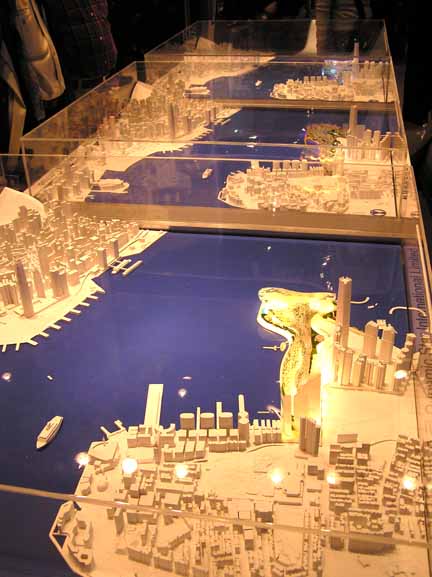
From the center, the attendee can move through the three different project rooms. Each room contains a larger scale model, together with scale models of the major facilities (such as the performance venue). Each room has more fancy free literature, large-sized television screens for multimedia presentations, spokespeople to answer questions and conveys the impression that the company has made a serious investment here for the bid.
Dynamic Star International
Overall plot ratio 3.28 (estimate)
Building height Up to 326 metres (80 floors)
Core arts and culture 278,700 sq m (plus additional 37,100 sq m)
Commercial, entertainment, offices 232,250 sq m
Residential 671,600 sq m (13 blocks)
Open space 300,000 sq m
The total site is about 400,000 sq m in area
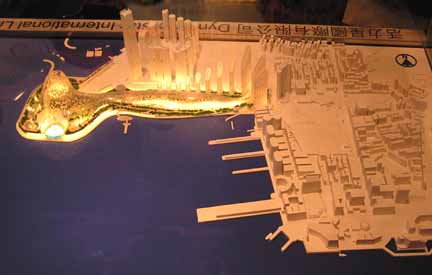
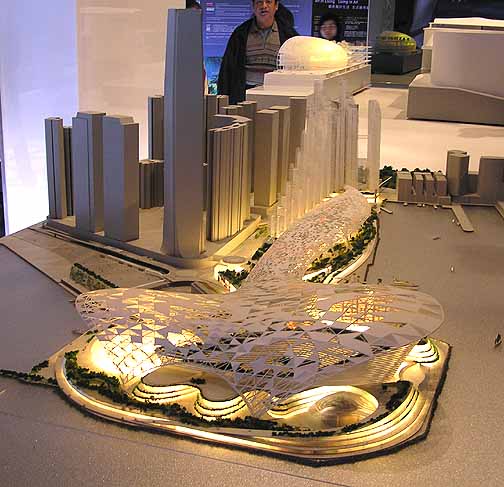


World City Culture Park
Overall Plot ratio 2.5
Building Height Up to 52 floors
Core arts and culture 252,378 sq m (plus additional 48,000sq m)
Commercial, offices 360,000 sq m
Residential 272,800 sq m
Open space 137,668 sq m
Hotel 50,100 sq m
Government and community area 20,000 sq m
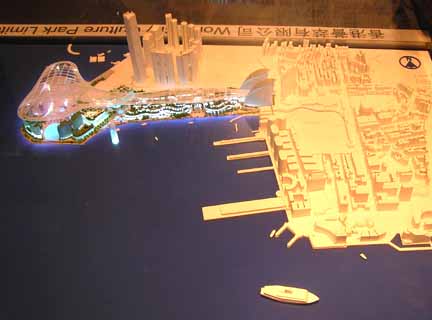
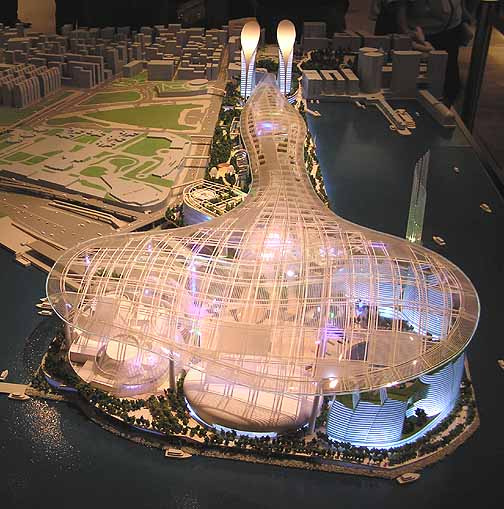


Sunny Development
Overall plot ratio 4.327
Building height Up to 68 floors
Core arts and culture 379,540 sq m (plus additional 34,390 sq m)
Commercial, entertainment, offices 342,420 sq m
Residential 829,530 sq m (5,523 units)
Open space 400,000 sq m
Hotel and conference centre 127,650 sq m
Government and community area 21,340 sq m

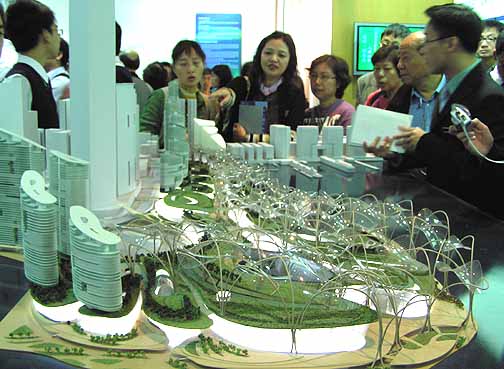
At the time when I was walking around, there was a large group of school children out on a field excursion to see what will happen to their city. This is a better civic experience than watching the Chinese national anthem on television.

This particular exhibition is supposed to part of a 15-week public consultation campaign. So the developers use this exhibition to showcase and explain their proposals with slick presentations. How is the public supposed to provide feedback? There is a comment card that can be filled out and returned. Here are some of the questions:
Q1. Integrated Development / Balanced Development Mix. Rate the three projects on (a) the plot ratio and development intensity; (b) the development mix of commercial, residential and hotel development; (c) the built form and height and impact of the buildings on the skyline are in harmony with nearby developments and the waterfront environs; (d) the proposal is most attractive to the general public and overseas visitors; (e) overall, which proposal is the best in terms of balanced development mix?
Q2. Design and Physical Layout. Rate the three projects on (a) master layout of the WKCD; (b) mix of arts and cultural facilities; (c) design (exterior and interior) of the arts and cultural facilities; (d) design and layout of waterfront promenade, piazzas and other open space; (3) accessibility and pedestrian circulation system and linkages including the automated people mover; (f) overall, which proposal is the best in terms of design and physical layout of the whole district?
Q3. Design for the Canopy. Rate the three projects on (a) it provides a pleasant sheltered environment for public space underneath; (b) its unique design is most likely to make it a waterfront landmark that will attract overseas visitors and local residents; (c) it has state-of-the-art architectural and engineering design with the strongest artistic appeal; (d) overall, which proposal is the best in terms of design for canopy?
Q4. Operating the Arts and Cultural Facilities. Rate the three projects on (a) providing high quality and varied programmes and exhibitions; (b) partnership with local and overseas arts organisations and museums; (c) provision for resident companies in the theaters; (d) providing education facilities and programmes; (e) attracting patronage of both local and overseas visitors; (f) proper management and maintenance of arts and cultural facilities; (g) overall, which proposal is the best in terms of the operation of arts and cultural facilities of the West Kowloon Cultural District?
Q5. Governing the Arts and Cultural Facilities. Rate the three projects on (a) a governing structure that is effective, efficient and sustainable; (b) a governing structure that is transparent and accountable; (c) channels are available for arts professionals to participate in the governance; (d) channels are available for experts in relevant fields to participate in the governance; (e) channels are available for community to participate in the governance; (f) overall, which proposal is the best in terms of the governance of arts and cultural facilities of the WKCD?
Q6. Going Forward Having regard to the three proposals and the information provided, which of them, if any, would you like the Government to take forward to the next phrase, subject to your suggested improvments? If you believe that none of the three proposals should be take forward by the Government, please indicate and explain why.
It is optional to provide your name, Hong Kong ID# and contact information. It is also optional to answer "To the best of your knowledge and belief, are you affiliated or connected with, or a spokesperson for, any organisation related to the proposals on display, or any property, or with the managers, directors or controllers of any such organisations or property developers?"
Forget about the school children for now, and let us stick to the 3.2 million registered voters of Hong Kong. For this battery of questions, I would say that a vast majority of them won't bother to even read them, much less to answer them. There will be a small minority who will make an effort to obtain the background information in ordered to provide informed and thoughtful answers.
But even here, some things are unknowable. An example of something that I can work out is the "the built form and height" since these are numbers that I can look up. I am asked to give an aesthetic judgment on the "impact of the buildings on the skyline are in harmony with nearby developments and the waterfront environs" and that is fair.
But I have a problem about answering whether the canopy will be a "waterfront landmark that will attract overseas visitors." How can I know at this time who's got the best canopy in this sense? I also have problems with deciding which governing structure is the most 'effective, efficient and sustainable.' How can that be determined from reading the public relations statements provided by the developers?
Sure, you can ask me these questions. I will give you some answers that can be said to be informed, I will offer you some groundless personal guesses, and then I will be pulling stuff out of the air quite often too. Are you sure that my answers are valuable to the decision? There is nothing about majority-rule democracy that guarantees the objectively optimal answer all of the time. The only thing that is guaranteed that many people may be pleased to be asked, but that does not make it the 'right' or 'best' decision. Sometimes, there is another basis for making decisions.
For example, you can have a referendum question, "Should the government give each citizen 10,000 dollars at the end of the year?" Based upon personal greed, the majority would vote yes, but that would be financially irresponsible because that money has to come from somewhere (and inflation would result if this is done by just printing more money). Would the Eiffel Tower be built if it were up to the public?
The consultation with the general public is part of the total assessment for WKCD, which also includes consultations with other organizations. I don't know what the relative weights between the general public and the others are, but I certainly would not give a lot of weight to my personal answers to these questions.
Somewhere back there, I have a relevant experience of urban living. I lived in Midtown South of Manhattan (New York City) for several decades. By the time I got there, the old and decrepit West Side Highway was finally demolished. What was going to take its place? This was a highway that runs from Battery Park at the southern tip of Manhattan (where tourists board the ferry to the Statue of Liberty) all the way along the Hudson River to the northern tip of the island. Various real estate developers came in with proposals that were the usual mix of commercial-cultural-residential-public space elements. But over the years, every single project was shot down due to objections from community activists.
I am sure that those people were acting sincerely to protect the environment, the community and the quality of life. But here is my reality: I lived along one of the most beautiful riverbanks of the world, with a beautiful sight of the Statue of Liberty at sunset. But I had no easy or comfortable access. The piers along the riverbank were all padlocked because they were rotting and perilous. The riverbank walkway was pockmarked with potholes because the developmental process was held in limbo. To get to the riverside, I had to walk through the old meatpacking district even though as it was irrational to have slaughterhouses and cold meat storage warehouses in Manhattan, but re-zoning was also held in limbo. Those streets were mostly deserted except for the transexual prostitutes who hid in the doorways and the foot-long rats that were attracted there by the carcasses. I had to put up with that kind of scene scene for several decades. I cannot accept that my community was better, my environment was cleaner and my quality of life was superior during those lost decades.
Now take a look at this current West Kowloon district. There is nothing on it right now except dirt and grass. Will this Cultural District project be shot down by public opinion and/or lawsuits? How many decades will it take before something (anything) finally appears? Remember Hong Kong is a place that motivates its elected legislators to grandstand in public and allows citizens to file frivolous lawsuits under the rule of law. And those decades will be lost years.

The other lesson from New York City is that some things did work there, as when the twentieth century saw the undertaking of huge public construction projects such as the Triborough, Whitestone, Throgs Neck and Verrazano bridges; public buildings such as the Lincoln Center, the New York Coliseum, the United Nations complex, Shea Stadium and the 1964 New York World's Fair; highways such as Cross Bronx Expressway, Major Deegan, Bruckner Expressway, Gowanus Expressway, Whitestone Expressway, Brooklyn-Queens Expressway, Clearview, Sheridian, and the Harlem River Drive; a system of state parks such as Jones Beach, Sunken Meadow, Heckscher and others. People may not agree with the asthetics, philosophy or efficiency, but millions of New Yorkers use those facilities without thinking about what life would be without them.
Today, given the financial situations of the city and the state, it is unthinkable that public works programs of those magnitudes could be even contemplated. So how did it happen back then? Public construction was the kingdom dominated by one personality: Robert Moses, who is variously compared to Napoleon, Caesar, the Czar and the like (note: there is a magnificent biography of the man by Robert Cato) and democracy had nothing to do with it. If those projects were placed as referendums, perhaps none would have been realized.
Am I a crypo-fascist? In a way, yes. But let's get real -- look at the United States of America. The people had their chance in an open election and they chose President George W. Bush. But the people did not get to vote on going to war in Iraq. If every major decision or policy has to be voted upon separately, then what is the point of electing a President? Besides going to war involves the assessment of many sources of information that may be too specialized or complicated for ordinary citizens. Does that sound familiar?